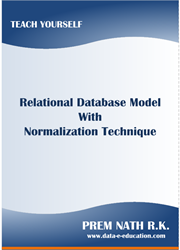

- Relational Algebra Operators
-
- Operators and Symbols
- Selection Operator
- Projection Operator
- Cartesian Product Operator
- Natural Join Operator
- Theta Join Operator
- Left Outer Join Operator
- Right Outer Join Operator
- Full Outer Join Operator
- Division Operator
- SET Union Operator
- SET Difference Operator
- SET Intersection Operator
- Rename Operator
Referential Integrity Constraints
Referential Integrity Constraint is ensures set of attributes data values that appears one Relation into another Relation with common set of attributes. Different Tables can be related through common columns and the Referential Integrity Rules guarantee the relationship in the Relational Database Model.
Foreign Key is used to define Referential Integrity Constraint with one column or set of columns that reference a Referenced Key in the Relational Database. Referenced Key is used to define Referential Integrity Constraint with Unique or Primary Key that referenced by Foreign Key in the Relational Database.
Foreign Key must define in the Child Table and Unique or Primary Key must define in the Parent Table. An instance, EMP is a Child Table that referenced DEPT Parent Table through common Dept_Code column. Relational Database Model authorizes to match the Foreign Key Data with Referenced Primary or Unique or NULL Data.
Referential Integrity Constraints can define with set of actions that execute automatically when modify the Referenced Parent Key Data. Most of the RDBMS support UPDATE and DELETE NO ACTION, ON DELETE CASCADE and SET NULL options. These actions must define in the Child Table.
UPDATE and DELETE NO ACTION is used to avoid update or delete referenced records in the Parent Table. ON DELETE CASCADE is used to delete referenced records in the Child Table when delete a referenced records in the Parent Table. SET NULL is used to update referenced records in the Child Table with NULL value when delete a referenced records in the Parent Table.
Referential Integrity Constraint is ensures set of attributes data values that appears one Relation into another Relation with common set of attributes. Different Tables can be related through common columns and the Referential Integrity Rules guarantee the relationship in the Relational Database Model.
Foreign Key is used to define Referential Integrity Constraint with one column or set of columns that reference a Referenced Key in the Relational Database. Referenced Key is used to define Referential Integrity Constraint with Unique or Primary Key that referenced by Foreign Key in the Relational Database.
Foreign Key must define in the Child Table and Unique or Primary Key must define in the Parent Table. An instance, EMP is a Child Table that referenced DEPT Parent Table through common Dept_Code column. Relational Database Model authorizes to match the Foreign Key Data with Referenced Primary or Unique or NULL Data.
Referential Integrity Constraints can define with set of actions that execute automatically when modify the Referenced Parent Key Data. Most of the RDBMS support UPDATE and DELETE NO ACTION, ON DELETE CASCADE and SET NULL options. These actions must define in the Child Table.
UPDATE and DELETE NO ACTION is used to avoid update or delete referenced records in the Parent Table. ON DELETE CASCADE is used to delete referenced records in the Child Table when delete a referenced records in the Parent Table. SET NULL is used to update referenced records in the Child Table with NULL value when delete a referenced records in the Parent Table.
|
|
Copyright © 2010 data-e-education.com. All rights reserved.
